Category: Science
- Home
- /
- Shop
- /
- By Subject
- /
- Science
- /
- Page 17
Showing 321–340 of 344 resultsSorted by latest
-
 $15.00Buy Now
$15.00Buy NowThis Physics and Earth Science student textbook is designed to use with middle school students (specifically those learning at or ready for 8th grade work). View the table of contents in the description below.
Preview video of the companion 8th Grade Science: Biology & Chemistry textbook here.
Get the TEACHER’S EDITION here!
Bundle and Save: 8th Grade Science Curriculum Bundle
-
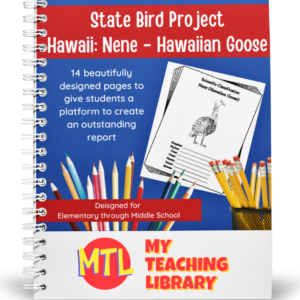 $3.00Buy Now
$3.00Buy NowStudying the state of Hawaii? Perhaps doing a unit on Ornithology? This project-based unit is designed to help students study and record information about Hawaii’s state bird – the Nene (Hawaiian Goose)! To learn more, see details below or you can preview a similar product here.
-
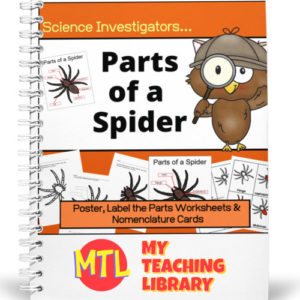 $2.00Buy Now
$2.00Buy NowHelp students learn the parts of a spider with this fun arachnid resource! Students will learn the following parts: eyes, fangs, cephalothorax, abdomen, spinnerets, legs.
Includes:
- – Color poster
- – 2 Worksheets – One for students to write and label, the other to cut and paste.
- – 1 Science Center activity
- – Nomenclature flashcards – Labeled
- – Blank Cards for students to complete
-
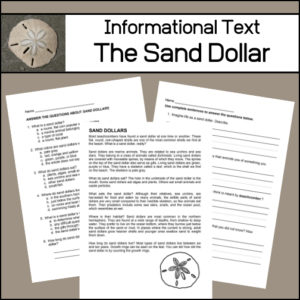 $1.50Buy Now
$1.50Buy NowThis informational article will teach students about the sand dollar. They will learn that the little round, coin-shaped shell found on the beach is actually part of a marine animal, related to sea urchins and sea stars. They will also learn how living sand dollars move, that they aren’t ‘white’, how and what they eat and much more. After reading, students will complete two worksheets (multiple choice and short answer) to assess their comprehension / understanding of the material. Answer Key is provided.
Automated Readability Index: 4.8
Grade level: 8-9 yrs. old (Fourth and Fifth graders)
Linsear Write Formula : 5.6
Grade level: Sixth Grade. -
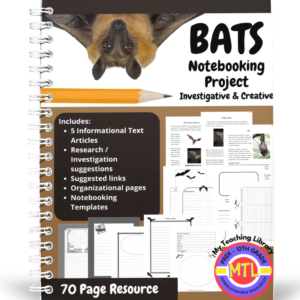 $8.00Buy Now
$8.00Buy NowStudying bats? Here is a resource that will allow students to create a beautiful project that will show off what they’ve learned. This 70 page project unit can be used as a fully contained project resource (with no needed outside information required) or can be a launch for a full-blown research project using additional resources and includes:
- – Explanation page about creating a notebooking project
- – Suggested supply list
- – Evaluation rubric
- – Assignment page
- – Table of contents pages
- – Vocabulary & Reference pages
- – List of bat related vocabulary
- – Suggested links (optional)
- – Research / Notebooking questions/investigation suggestion handouts
- – 5 Informational text articles
- – Project KWL
- – Notebooking template pages
- – Bat pictures
-
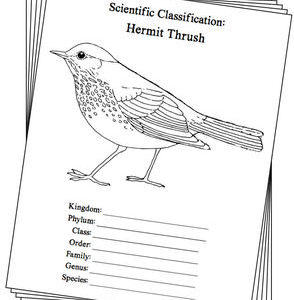 $3.00Buy Now
$3.00Buy NowStudying the state of Vermont? Perhaps doing a unit on Ornithology? Check out this Notebooking set designed around the Vermont State Bird!
What type of pages are contained in this set:
– A map page (for the state)
– Scientific classification page
– A page for students to give details about the bird’s physical description, habitat, diet, life span and reproduction
– A page where students will do additional map work to show where in the U.S. the bird lives in addition to migration information
– Coloring page
– Several pages on which students can use for expository and/or creative writing as well as sections in which students may draw.14 pages in all and is designed for different levels / abilities.
-
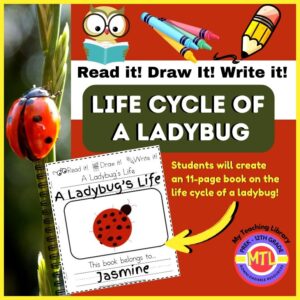 $3.50Buy Now
$3.50Buy NowA cross-curricular (Science / Literacy – Writing) product that will have students creating their very own mini-books detailing the life cycle of a ladybug!
Knowledge students will learn:
- -The ladybug is a beetle
- -Mother ladybugs lay tiny yellow eggs in clusters under a leaf
- -When the larva hatches, it eats. What do ladybugs eat? Students will find out!
- -What the ladybug pupa looks like before attaching itself to a leaf
- -The pupa grows, molts and changes…emerging as a ladybug!
Students will:
- -Read the text
- -Draw a picture
- -Write (copy work) the written text.
Benefits of this resource:
- -Low prep – print and give to students
- -Children learn about the ladybug life cycle while reading, drawing and writing
- -Encourages fine motor skills through coloring and writing plus scissor skills as the cut out each page along the dotted lines
- -Encourages reading skills as students read and copy the text
- -Finished book can be a keepsake Science mini-book and added to end-of-the-end portfolio.
What is included? 11 ready-to-use student pages
⭐⭐Use along or with: Ladybug Life Cycle | Posters and Worksheets
-
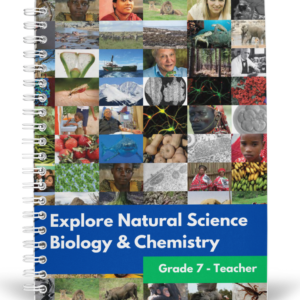 $15.00Buy Now
$15.00Buy NowThis is the Teacher’s edition for Natural Science: Biology & Chemistry – Grade 7 (Student Edition)
Bundle and Save: 7th Grade Science Curriculum Bundle
-
 $2.50Buy Now
$2.50Buy NowThis Science lab worksheet and rubric will give your middle school and high school students an organized way to report the entire process of a science lab. Plus, the rubric can be given to students in advance so that they will know all of the criteria you are expecting! Use again and again, throughout the year for all your labs
There are sections for students to record…
- – Lab title
- – Introduction (Students are to state what they are testing and why plus give background information)
- -Hypothesis (Students are to write their hypothesis plus give the independent and dependent variables)
- -Materials (A complete list of materials)
- – Procedure (Students are to give detailed numbered steps that were followed)
- – Data (Should include a table)
- – Conclusion (Students will state if their hypothesis was correct, providing evidence. Change the hypothesis is necessary.)
- – Reflection (Students should list at least two sources of possible error)
The grading rubric makes it easy for YOU to grade!
-
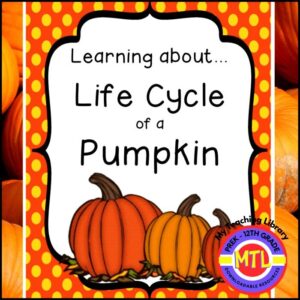 $3.00Buy NowThis unit covers the life cycle of a pumpkin!Includes:
$3.00Buy NowThis unit covers the life cycle of a pumpkin!Includes:-
B/W Life Cycle poster
-
Color Life Cycle poster
-
Word Wall Vocabulary
-
Sequencing cards
-
Life Cycle Worksheet (Cut-n-paste)
-
Life Cycle Vocabulary matching
-
Life Cycle Drawing
-
Life Cycle Shape Book activity
-
(Bonus Coloring page AND Pumpkin Seeds for counting)
-
-
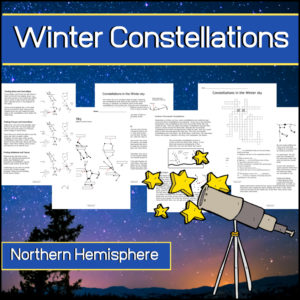 $3.00Buy Now
$3.00Buy NowExplore the Northern Hemisphere’s Winter constellations with this resource! Students will learn…
- What are the major constellations?
- What is the Greek Mythology behind them?
- What major stars will help guide them through the night sky?
- How is Orion the ‘key’ to locating the main constellations?
- What is the name of the North Star, and which constellation is it in?
- What is the brightest star in the sky?
Students will learn about the following constellations:
- Orion
- Canis Major
- Canis Minor
- Gemini
- Auriga
- Pleiades
- Taurus
- Draco
- Ursa
- Major
- Ursa Minor
- Cepheus
- Cassiopeia
They will learn the location of the following stars:
- Pollux
- Castor
- Capella
- Procyon
- Sirius
- Betelgeuse
- Rigel
- Aldebaran
- Capella
- Polaris
They will also learn which constellations are called the Northern Circumpolar constellations PLUS the Greek Mythology behind these major constellations!
Student activity sheets include:
- Fill in the blank (constellation and star names for the ‘Winter Sky’)
- Draw and name (the five circumpolar constellations and the North Star)
- Crossword Puzzle (in which they will use the information within the resource to gather answers)
Suggested follow up activities:
- Assign students to go outside after dark, find and draw the constellations they see and can identify.
- Visit a local planetarium
-
 $2.00Buy Now
$2.00Buy NowThis informational text article is all about seals, where they live, their physical characteristics and about several different types of this cold-water mammal. After reading, students will complete a reading comprehension worksheet and (optional) write a story! Answer key provided.
-
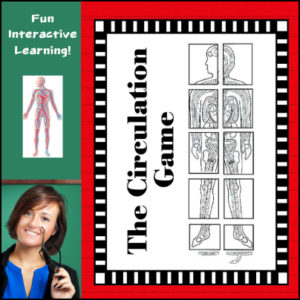 $4.50Buy Now
$4.50Buy NowA fun, interactive game that will have students learn all about the circulatory system!
- – deliver oxygen and food to the cells
- – have oxygen and carbon dioxide ‘ride’ on red blood cells
- – circulate red blood cells throughout the body – through the circulatory system (arteries and veins)
The first team to get all their oxygen to the cells, all the food to the cells, all the wastes to the kidneys and all the carbon dioxides to the lungs, wins the game!
-
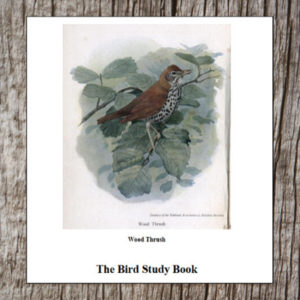 $2.00Buy Now
$2.00Buy NowThis is a downloadable copy of “The Bird Study Book” written in 1917. (108 pages)
Students will see drawings displaying different heads and feet (as a way to identify groups of birds), a sample report page, learn about protections give to migrating birds, interesting and fun facts about different species and more.About the book: Do you enjoy birdwatching? Would you like to learn a little more about the early conservations efforts to protect wild birds? In the Preface to The Bird Study Book, Pearson tells us “This book was written for the consideration of that ever-increasing class of Americans who are interested in acquiring a greater familiarity with the habits and activities of wild birds. Attention is also given to the relation of birds to mankind and the effect of civilisation on the bird-life of the country. ” An avid ornithologist, T. Gilbert Pearson (1873-1943) was a co-founder in 1905 of the National Association of Audubon Societies of which he was first secretary and then president for many years. He was also a pioneer of the conservation movement in the United States, international bird protection and broad nature education for school-aged children. (Audubon Magazine. 42: 370–371. Nov-Dec 1943)
-
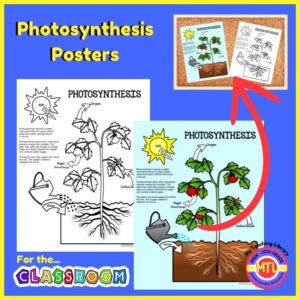 $2.25Buy Now
$2.25Buy NowThis resource gives you two photosynthesis posters, one b/w and the other color. Each poster has an easy-to-understand illustration plus a short explanation of the photosynthesis process is also included!
-
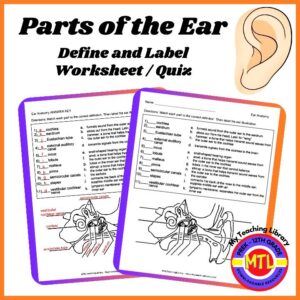 $1.50Buy Now
$1.50Buy NowA ready-to-print and use worksheet that will have students define and label parts of the human ear. Answer key provided.
Great learning tool or quiz!
Parts: cochlea, eardrum, Eustachian tube, external auditory canal, incus, lobule, malleus, pinna, semicircular canals, stapes, vestibular cochlear nerve
-
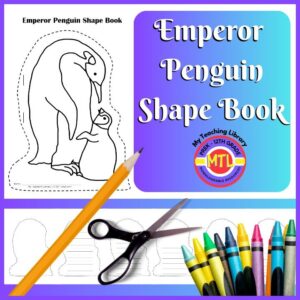 $2.00Buy Now
$2.00Buy NowStudying penguins or perhaps animals of the arctic? Here is a ready-to-use resource for students to publish stories, reports or poems about penguins.
You’ll find pages with both dotted-dashed lines as well as single lines so that you can use what best fits the level of your students.
-
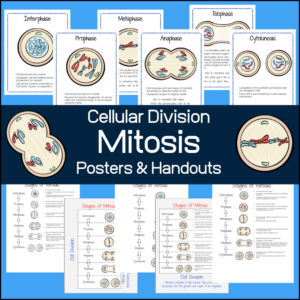 $3.25Buy Now
$3.25Buy NowThese Science posters and handouts are designed to help students learn the phases of cellular division / reproduction through the process of mitosis.
Phases outlined: Interphase, Prophase, Metaphase, Anaphase, Telophase and Cytokinesis.
Included: Both color and b/w posters / handout, with and without explanations of what actually occurs during each phase.
-
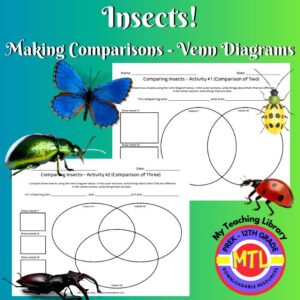 $2.25Buy Now
$2.25Buy NowTWO ready to use Venn Diagram Science activities for students to use to compare 2 or 3 insects. On each, students will list the insects they will compare and contrast, draw a picture of each and then complete the Venn Diagram.
Extend the activity by asking students to write a paragraph or short report about their discoveries!
-
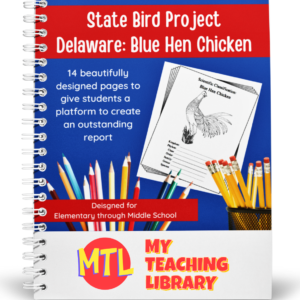 $3.00Buy Now
$3.00Buy NowStudying the state of Delaware? Perhaps doing a unit on Ornithology? This project-based unit is designed to help students study and record information about Delaware’s state bird – the Blue Hen Chicken! To learn more, see details below or you can preview a similar product here.

